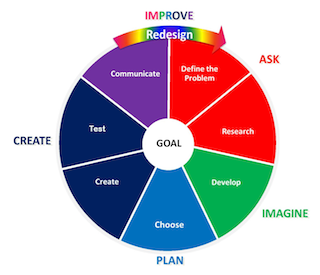Every STEM Teacher Is ‘”NEW” in 2022
A MiddleWeb Blog
 My head spins when I look around at schooling today and think about teaching STEM.
My head spins when I look around at schooling today and think about teaching STEM.
Teaching has always been difficult, but hybrid STEM? Online STEM? STEM lacking lab experiences and materials? Student teams with no face-to-face interaction? Teachers with little or no preparation for digital instruction in the sciences? Really?
That’s difficult – and confusing! STEM education needs rebuilding quickly, and it involves a process of overhauling the airplane while we’re flying it. With that in mind . . .
Resiliency and relearning may be the new super-powers for STEM teachers!
You may be a current or soon-to-be STEM teacher, so here’s something you may already know: STEM teachers play the most crucial role in preparing students for the world and workforce. If that isn’t enough to unnerve you, consider this: being a STEM teacher will likely be a new experience every day. I look at it like this:
ALL STEM teachers are “new” STEM teachers in our 2022 world.

To cope with that unsettling news, what fresh strategies and ideas do you as a “new” STEM teacher need? The short answer: Who knows? We’re in unknown territory – a rapidly developing digitized era demanding unprecedented creativity, innovation, and wholly new products, services, and solutions. No process or formula exists to prepare any teacher for that. There’s not an app for that.
First think about you.
To help you stay sane, healthy, and enjoying teaching, consider your own needs as a STEM teacher. My top four suggestions for doing this:
► Trust yourself. Understand that you will certainly make mistakes and learn from them. That’s the job, so go ahead and take risks. Be confident that you can learn, grow, and offer quality learning to students.
► Be flexible. Being flexible today is a continual work in progress. Stay abreast of what’s emerging in the workforce and world. Recognize when to modify and adapt what you’re doing and how you’re doing it as new information comes your way.
► Don’t go it alone. Draw knowledge, encouragement, and teaching power by working together with a team of colleagues for support. Find instructional solutions together.
► Monitor your own SEL progress, especially in areas of self-awareness, self-management, decision-making, social awareness, and empathy. You can get more info about that here.
Now think about your students.
What does research tell us that current STEM lessons need to focus on? Take a look at key findings from this Schools of the Future publication from the World Economic Forum. Download the PDF and go to page 4 for a summary of current basic principles for teaching STEM.
Now build these findings into your STEM content and experiences. (The publication can provide you with ideas for including these findings in STEM lessons.) Drawing on some of those findings, I think these aspects may add the most value to your STEM curriculum.
1. An awareness of the wider world. Help your students understand sustainability and the need to play an active role in an interdependent global community. Ideas for teaching this are plentiful. Here’s one site. Perhaps my favorite site for students to have fun and connect globally is Design Squad Global.
2. Innovation and creativity skills. Kids need playful, interesting, and enjoyable approaches for solving problems. (STEM requires identifying, defining, and solving complex, meaningful problems.) Need ideas for building those into a lesson plan? Check out these sites for Innovation and Creativity.
3. Interpersonal skills. SEL skills are increasingly in-demand in today’s society, and their importance is growing. Students need to mature in empathy, collaboration, compromise, leadership and social skills. These can be seamlessly incorporated and emphasized in STEM lessons. Here’s one SEL guide.
4. Technology competencies. When working on STEM projects, students should use current technology and digital skills, including programming where appropriate. They also need to understand digital responsibility. You can type digital tools into a search engine and be inundated with possibilities. Lots of blog sites focus on digital tools for specific purposes. For example, in this post Kathleen Palmieri shares how she uses a free digital platform to create interactive student notebooks. This site has great info on digital responsibility.
5. A problem-based, collaborative learning approach (PBL). This approach is key to an authentic STEM project. PBL offers kids ownership of their learning and opportunities for personalized, inclusive experiences. The embedded teamwork gives them chances to practice peer collaboration and to develop skills mirroring those needed in the workforce. Heather Wolpert-Gawron explains PBL instruction this way.
6. A commitment to lifelong learning. Your students need to think about learning as a process that never ends – a way to meet needs as they arise. They need to dedicate part of their life to continual learning – to improving their existing skills and gaining new ones centered on what they need to know. Their learning can occur in many ways, but it must be intentional. Some ways to engage in lifelong learning are listed in this article. You’ll need to think in middle-school terms to apply it to your students.
 Compare these tips with the six tips I provided “sudden” STEM teachers in this post. At that time, I considered new teachers as those who had never taught STEM.
Compare these tips with the six tips I provided “sudden” STEM teachers in this post. At that time, I considered new teachers as those who had never taught STEM.
Frankly, those tips continue to be “must-have” additions to your current STEM curriculum. Your students still need to understand both the Engineering Design Process and the Product Design Process (which I wrote about here recently) if they plan to create a prototype.
They need to function productively in teams and to focus on solving real problems and addressing global challenges, including plastics pollution. Your lessons should include grade-level science and math content and incorporate all four STEM subjects (not necessarily at the same time).
What if you’re teaching an entirely new approach, such as an online STEM course or using a hybrid approach? This post contains current information on virtual STEM lessons, but stay tuned! I’m currently investigating this in more depth. Feel free to share your ideas with me and others via commenting to this post.
No easy answers, but lots of support
I wish I could give you 800 words that tell you everything you need to know about STEM and how to teach it today. It’s just not possible. However, if you take time to follow the links suggested in this post you should begin feeling a bit more prepared and knowledgeable about this topic.
NOTE: If your school has the option and the interest to invest in an innovative, hands-on middle school curriculum designed to prepare kids for the workforce and provide the skills mentioned in this post, be sure to check out the We Build It Better modules. Created by a nonprofit group and supported by leading technology companies, this learning system was developed with middle school in mind.
(Full disclosure: I was a curriculum developer for this project and some of my current thinking was shaped by my involvement.)

































